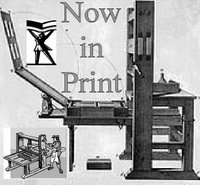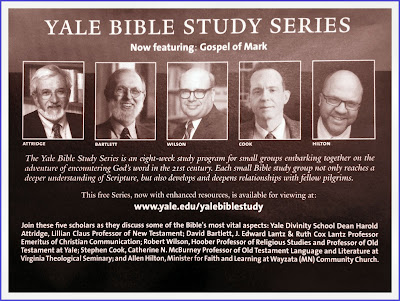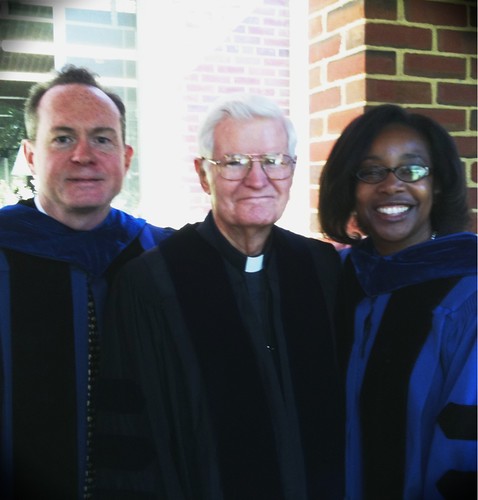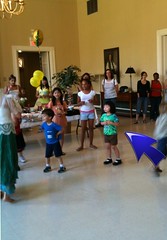Tuesday, May 25, 2010
Monday, May 24, 2010
187th Commencement at VTS, continued
For video of the commencement last Thursday, click here.
Here are a few more snapshots from the day's events:




Here are a few more snapshots from the day's events:




Thursday, May 20, 2010
Wednesday, May 19, 2010
"Vision of Deuteronomy" (3rd of 3 posts)
The discussion here continues from my two preceding posts:

Not everything is completely bright and sunny as we move past the mountain of the covenant and into the right side of Pierre-Henry's image. We do get a clear sky that "represents the new life in the Promised Land, under God's love and protection." However, a dark cloud in the upper right represents "the realism of Deuteronomy--that not everything will go perfectly." At the same time, there is a positive aspect to this cloud. For Pierre-Henry, it also represents the cloud of God (cf., e.g., Numbers 11:25 E; Mark 9:7). The cloud both reveals God and conceals God, preventing any dangerous direct contact with the divine, which would be deadly (see e.g., Deuteronomy 4:33).

Class discussion and reflection on the image revealed several interesting dimensions of interpretation. Gary Taylor, for example, noted that as the eye moves from left to right, out of Egyptian slavery into the Promised Land, the eye must broaden its perspective to take in more along the vertical axis. At the top we have the cloud of God's presence; at the bottom we have the tree planted by the stream, symbolizing God's good, bountiful life in the land (cf. Jeremiah 17:7-8). As the journey of Deuteronomy progresses, there is a broadening of spiritual perspective, a broadening of the richness of life. Deuteronomy's broad, good life includes God's presence and life in community rooted in the material, natural world.

Not everything is completely bright and sunny as we move past the mountain of the covenant and into the right side of Pierre-Henry's image. We do get a clear sky that "represents the new life in the Promised Land, under God's love and protection." However, a dark cloud in the upper right represents "the realism of Deuteronomy--that not everything will go perfectly." At the same time, there is a positive aspect to this cloud. For Pierre-Henry, it also represents the cloud of God (cf., e.g., Numbers 11:25 E; Mark 9:7). The cloud both reveals God and conceals God, preventing any dangerous direct contact with the divine, which would be deadly (see e.g., Deuteronomy 4:33).

Class discussion and reflection on the image revealed several interesting dimensions of interpretation. Gary Taylor, for example, noted that as the eye moves from left to right, out of Egyptian slavery into the Promised Land, the eye must broaden its perspective to take in more along the vertical axis. At the top we have the cloud of God's presence; at the bottom we have the tree planted by the stream, symbolizing God's good, bountiful life in the land (cf. Jeremiah 17:7-8). As the journey of Deuteronomy progresses, there is a broadening of spiritual perspective, a broadening of the richness of life. Deuteronomy's broad, good life includes God's presence and life in community rooted in the material, natural world.
Tuesday, May 18, 2010
"Vision of Deuteronomy," continued (2)

Another interesting dimension of Pierre-Henry's image, introduced in yesterday's post, is what he calls the tormented sky to the left of Mount Horeb. He explains that it symbolizes both the difficult life in Egypt and, at the same time, the liberation by God along with God's guidance through the pillar of cloud. The pillar, which is visible in the center of the dark sky, is mentioned in Deuteronomy 31:15, as well as in E texts that are antecedent to D (see Exodus 33:9-10 and Numbers 12:5).

Underneath the tormented sky lie the three pyramids, which Pierre-Henry explains indicate that "Egypt remains a possibility." "Egypt could be the temptation of facility, temptation of security." On the temptation to return to Egypt, see Deuteronomy 17:16. For an E text antecedent to this theme, see Exodus 13:17. For one of my blog posts related to this topic, click here.
Monday, May 17, 2010
"Vision of Deuteronomy," by Pierre-Henry Buisson
As his final project for my Deuteronomy seminar, my student Pierre-Henry created this visual representation of some central themes of our course work together. Take a moment to give the painting a close look, and feel free to add your interpretations of the piece using the "comments" function below.

At the center of the image is Mount Horeb/Sinai, the mountain of God's revelation, of Israel's assembly, and of the alliance between God and God's people. Pierre-Henry notes that as the eye moves across the painting from left to right, one leaves the darkness of slavery in Egypt and begins to experience a brighter side of promise on the right. On the far left side of the painting in the middle of the left border, one can see the pyramids of Egypt on the horizon. As the journey of Deuteronomy progresses, one's eye leaves the symbols of slavery and moves diagonally down to the right, past Sinai and the giving of the Torah, into covenant, love, and justice, symbolized by the clasped hands in the Jordan river, and then into the lush green land of promise, where, along with the image of the tree, one finds community rooted in the land, linking human mutuality and its material supports.

The sun-like, volcano-like, ball of fire atop Mount Sinai represents Pierre-Henry's interpretation of Deuteronomy 4:11-12. The Deuteronomic tradition is fond of conveying the awe-inspiring nature of God's appearance with the use of thunder-storm imagery (also cf. 1 Kings 19:11ff.). Much more could be said about the motif in Deuteronomy that God spoke to God's people out of the midst of the fire (see Deut 4:12, 15, 33, 36; 5:4, 22-26; 9:10; 10:4). There are rich connotations here about the nature of God's dangerous intimacy, God's apartness, and the key instrumentality of God's Word.

At the center of the image is Mount Horeb/Sinai, the mountain of God's revelation, of Israel's assembly, and of the alliance between God and God's people. Pierre-Henry notes that as the eye moves across the painting from left to right, one leaves the darkness of slavery in Egypt and begins to experience a brighter side of promise on the right. On the far left side of the painting in the middle of the left border, one can see the pyramids of Egypt on the horizon. As the journey of Deuteronomy progresses, one's eye leaves the symbols of slavery and moves diagonally down to the right, past Sinai and the giving of the Torah, into covenant, love, and justice, symbolized by the clasped hands in the Jordan river, and then into the lush green land of promise, where, along with the image of the tree, one finds community rooted in the land, linking human mutuality and its material supports.

The sun-like, volcano-like, ball of fire atop Mount Sinai represents Pierre-Henry's interpretation of Deuteronomy 4:11-12. The Deuteronomic tradition is fond of conveying the awe-inspiring nature of God's appearance with the use of thunder-storm imagery (also cf. 1 Kings 19:11ff.). Much more could be said about the motif in Deuteronomy that God spoke to God's people out of the midst of the fire (see Deut 4:12, 15, 33, 36; 5:4, 22-26; 9:10; 10:4). There are rich connotations here about the nature of God's dangerous intimacy, God's apartness, and the key instrumentality of God's Word.
Sunday, May 16, 2010
Moshe Greenberg, 1928 - 2010

Moshe Greenberg, a masterful Jewish Biblical Scholar has died this weekend. Among his many contributions to our field, Greenberg is known for his sensitive exegesis, respectful of the self-understanding of the biblical text, for his appreciation of the holistic, final-form of the Scriptures, with all their rich literary and theological integrity, and for the continuing contributions and insights to be found in the premodern classical Jewish interpreters, such as Rashi and Radak. I was privileged to study Ezekiel with Moshe Greenberg during one of his leaves from Jerusalem to teach at Yale.
For a good summary biography by Prof. Jeffrey H. Tigay, click here.
HT: Agade mailing list.
Saturday, May 15, 2010
Friday, May 14, 2010
Monday, May 03, 2010
Now in Print: Staying One, Remaining Open

I am excited to announce that the new collection of essays by our seminary faculty honoring the tenure of Martha Horne as dean and president of Virginia Theological Seminary (1993-2007) is now in print from Morehouse Press and available for about $20. The essays in the book are readable, fairly short, diverse, and provocative. My own contribution has allowed me to publish my critical reflections on a difficult text that has drawn my attention again and again: the Near Sacrifice of Isaac in Genesis 22. The essay, on pp. 125-138, is entitled: "Theological Exegesis of Genesis 22: Wrestling with a Disturbing Scripture."






